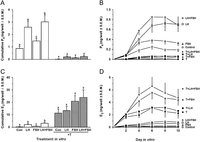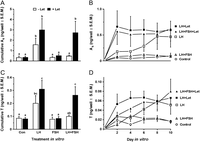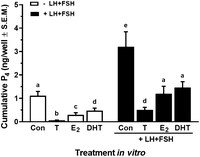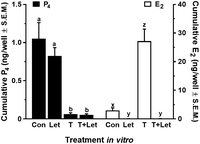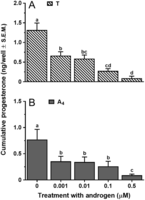Regulation of steroidogenesis in fetal bovine ovaries: differential effects of LH and FSH
- Correspondence should be addressed to J J Allen; Email: jja63{at}cornell.edu
-
Figure 1
Accumulation of progesterone (P4) and estradiol (E2) in cultures of fetal ovarian pieces over 10 days in control medium (Con) or with LH, FSH or LH + FSH (100 ng/mL), each in the absence (open bars) or presence (striped bars) of testosterone (0.5 µM). Both cumulative P4 (panel A) and E2 (panel C) over 10 days and time-courses for P4 (panel B) and E2 (panel D) production are shown. Means with no common letters (−testosterone: a–c; +testosterone: x, y) are different (P < 0.05). n = 14 cultures/treatment; 2 from each of 7 fetuses (81–114 days old).
-
Figure 2
Accumulation of androstenedione (A4) and testosterone (T) in cultures of fetal ovarian pieces over 10 days in control medium (Con) or with LH, FSH or LH + FSH (100 ng/mL), each in the absence or presence of the aromatase inhibitor letrozole (Let; 0.25 µM). Panels A and C show cumulative A4 and testosterone over 10 days, respectively, and time-courses are shown in panels B and D. Means within a panel with no common letters are different (P < 0.05). n = 10 cultures/treatment; 2 from each of 5 fetuses (76–89 days old).
-
Figure 3
Effects of graded doses of LH (0, 1, 2, 10, 50 and 100 ng/mL) on accumulation of progesterone (P4; panel A), androstenedione (A4; panel B) and estradiol (E2; panel C) over 10 days in cultures of fetal bovine ovarian pieces. Within a panel, means with no common letters are different (P < 0.05). n = 10 cultures/treatment, 2 from each of 5 fetuses (78–107 days old).
-
Figure 4
Effects of graded doses of FSH (0, 1, 2, 10, 50 and 100 ng/mL) on accumulation of progesterone (P4; panel A) and estradiol (E2; panel B) over 10 days in cultures of fetal ovarian pieces from each of 3 fetuses (78–99 days old; n = 6 cultures/treatment). Shown in panel C is the accumulation of E2 over 10 days with testosterone (T; 0.5 µM) and graded doses of FSH based on data from 5 fetuses (78–107 days old; n = 10 cultures/treatment). Within a panel, means with no common letters are different (P < 0.05).
-
Figure 5
Effects of control medium (Con), testosterone (T; 0.5 µM), estradiol (E2; 0.5 µM) and 5-alpha-dihydrotestosterone (DHT; 0.5 µM), each in the absence or presence of LH + FSH (both at 100 ng/mL), on the accumulation of progesterone (P4) in cultures of fetal ovarian pieces over 10 days. Means with no common letters are different (P < 0.05). n = 12 cultures/treatment; 2 from each of 6 fetuses (79–114 days old).
-
Figure 6
Effects of control medium (Con), letrozole (Let; 0.25 µM), testosterone (T; 0.5 µM) and Let + testosterone on the accumulation of progesterone (P4; black bars) and estradiol (E2; open bars) in cultures of fetal ovarian pieces over 10 days. For each steroid, means with no common letters (P4: a, b; E2: x–z) are different (P < 0.05). n = 6 cultures/treatment; 2 from each of 3 fetuses (79–89 days old).
-
Figure 7
Effects of graded doses of testosterone (T; panel A) or androstenedione (A4; panel B) on cumulative progesterone in cultures of fetal ovarian pieces treated with either androgen at 0, 0.001, 0.01, 0.1 or 0.5 µM for 10 days. Within a panel, means with no common letters are different (P < 0.05). n = 6 cultures/treatment; 2 from each of 3 fetuses, which were 78–89 (panel A) or 78–94 (panel B) days old.
-
Figure 8
Effects of graded doses of estradiol (E2; 0, 0.001, 0.01, 0.1 or 0.5 µM) on cumulative progesterone (P4; panel A), pregnenolone (P5; panel B) and androstenedione (A4; panel C) in cultures of fetal ovarian pieces over 10 days. Within a panel, means with no common letters are different (P < 0.05). n = 6 cultures/treatment; 2 from each of 3 fetuses (74–94 days old).
- © 2016 Society for Endocrinology
